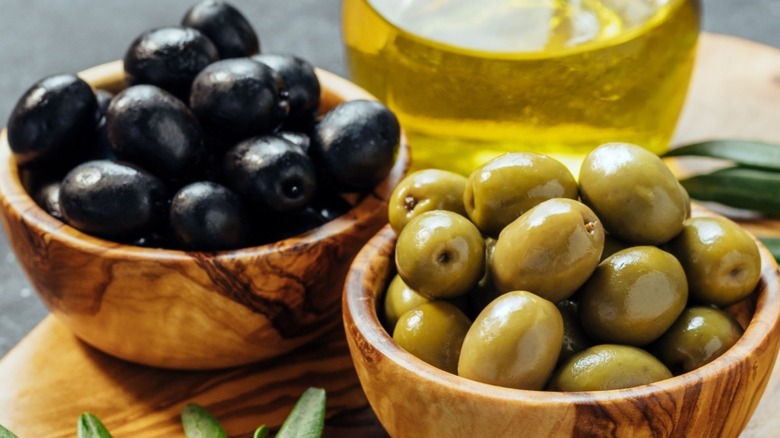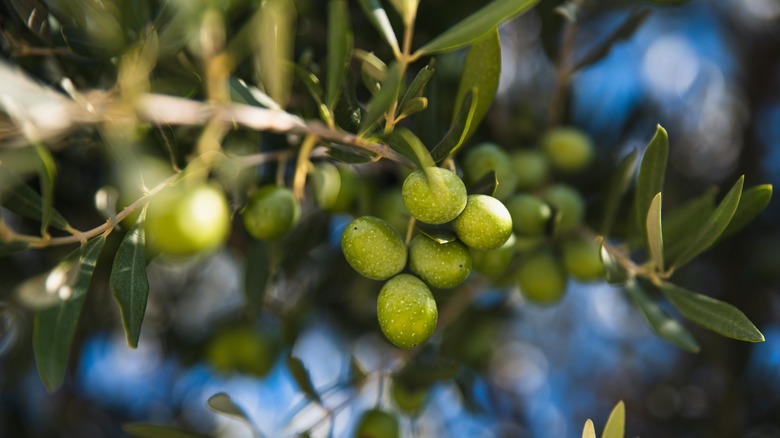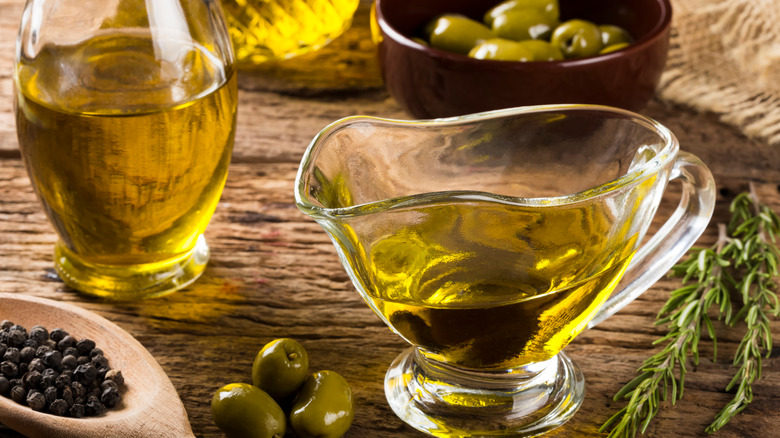Is There Really A Difference Between Green And Black Olives?
If you're an olive aficionado, you've probably picked a side between green and black olives. You might even be fiercely protective of your favorite type of olive. But aside from color, is there really a difference between the two?
While they both grow on the same tree, the main distinguishing factor between green and black olives is their level of ripeness when they are harvested. As one might suspect, green olives are picked earlier before they are ripened, whereas black olives have been left on the tree to fully ripen, per D'Olivo, an olive oil tasting bar in Washington.
Much like different grape varietals used in wines, there are flavor distinctions between green and black olives. Green olives generally taste more bitter and saltier due to a heavier brining, which is done to mitigate some of the unripe olive's natural bitterness. Black olives are a bit fruity, milder, and less salty, according to Tastessence. There is also a difference in texture. Black olives, having completely ripened, are softer, while green olives are generally "firmer and denser." This is why green olives are usually the type stuffed with cheese or other fillings, because they hold up better.
Production process, nutritional value, storage
As Shea Rosen of Italian food company Mezzetta told the Huffington Post, "raw and freshly picked olives are inedible due to their very strong bitter flavor." During the production process, both green and black olives are soaked in lye before being brined. The difference in taste comes in part from the duration of the brining — the longer the brine, the less bitter the olive becomes (via Spoon University). Green olives, the most bitter of the two, are fermented in brine, while black olives are cured in brine, which typically contributes to the saltier flavor profile of the former.
The good news is that regardless of whether you prefer green or black olives, you receive the same nutritional benefits from either. Olives are packed with Vitamin E and other antioxidants that deliver heart health benefits and may lower your risk of cancer and osteoporosis, per Healthline. They also contain monounsaturated fats, which are considered a healthier type of fat.
Storing your olives also doesn't change depending on the color of the olive. For proper storage, you'll want to keep any type of olive swimming in their liquid brine to help preserve them and enhance their flavor, and package them in a non-metal container after opening and transferring them to the fridge.
Dishes featuring green and black olives
We can all picture black olives on pizza or green olives adorning a dirty martini, but there are many more delectable dishes that feature either or both olive type. The experts at the aptly-named Olive Magazine recommend a chicken, red pepper, and olive cacciatore recipe. As an added bonus, this particular dish is low calorie and gluten-free.
If you want to make a different type of side for a dinner party or social gathering, the magazine also has a recipe for a mini herb, green olive, and buttermilk cornbread. As the name implies, this one calls for pitted green olives. For a multipurpose spread that uses black or green olives, you can make your own tapenade, a dip consisting of olives, capers, anchovies, and spices that is often paired with bread or used to jazz up a variety of dishes.
And let's not forget about olive oil. It's delicious as a stand-alone dip for breads and it can be incorporated into all types of cooking. Since green and black olives are exactly the same fruit, just plucked at different stages of the ripening process, both are used to make olive oil (via Oliviada). Just make sure to consult our guide on how to cook properly with olive oil so you know when and how to utilize it most effectively in your kitchen.


